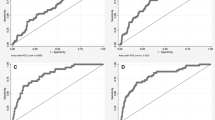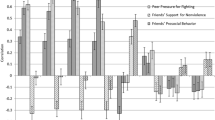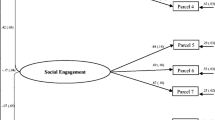Abstract
Peer and teacher assessments of aggression, social withdrawal, and likability using the Pupil Evaluation Inventory were recorded for 104 French Canadian girls and boys in grade 1. Self-reported delinquency and personality measures were administered to these children when they were in junior high school 7 years later. Linear regression analyses revealed significant predictive differences between the grade 1 assessment of girls and boys: For antisocial behavior, teacher and peer assessments of boys were equally good predictors, and the combination of the two assessments did not improve prediction; for girls, peer and teacher assessments taken separately were weak predictors, but, taken together, they were better predictors for girls than for boys; for personality, peers were better predictors than teachers both for girls and for boys. When categorical analyses were used to predict extreme antisocial behavior, peer and teacher assessments were equally good predictors for girls and boys. The use of peer and teacher ratings together, however, decreased the number of false positives. The implications of these findings for research and clinical work are discussed.
Similar content being viewed by others
References
Biron, L., Caplan, A. & LeBlanc, M.La construction de l'échantillon, la cueillette des données et leur préparation. Montréal: GRIJ, Université de Montréal.
Connolly, J., & Doyle, A.-B. (1981). Assessment of social competence in preschoolers: Teachers versus peers.Developmental Psychology, 17, 454–462.
Cowen, E. L., Pederson, A., Babigian, H., Izzo, L. D., & Trost, M. A. (1973). Long-term follow-up of early detected vulnerable children.Journal of Consulting and Clinical Psychology, 41, 438–446.
Crespo, M. (1977).Un instrument pour le choix des écoles élémentaires dans le cadre de l'opération renouveau. Montréal: Commission des Ecoles Catholiques de Montréal.
Edelbrock, C., Costello, A. J., Dulcan, M. K., Kalas, R., & Conover, N. C. (1985). Age differences in the reliability of the psychiatric interview of the child.Child Development, 56, 265–275.
Eysenck, S., & Eysenck, H. (1971). Crime and personality: Item analysis of questionnaire response.British Journal of Criminology, 14, 385–387.
Hindelang, M. J., Hirschi, T., & Weis, J. G. (1981).Measuring delinquency. Beverly Hills: Sage.
Jesness, C. F. (1972).The Jesness Inventory. Palo Alto, CA: Consulting Psychologists Press.
Landau, S., Milich, R., & Whitten, P. (1984). A comparison of teacher and peer assessment of social status.Journal of Clinical Child Psychology, 13, 44–49.
LeBlanc, M. (1983). Delinquency as an epiphenomenon of adolescence. In R. R. Corrado, M. LeBlanc, & J. Trépanier (Eds.),Current Issues in juvenile justice (pp. 31–48). Toronto: Butterworths.
Ledingham, J. (1981). Developmental patterns of aggressive and withdrawn behavior in childhood: A possible method for identifying preschizophrenics.Journal of Abnormal Child Psychology, 9, 1–22.
Ledingham, J. E., & Younger, A. (1985). The influence of the evaluator on assessments of children's social skills. In B. H. Schneider, K. H. Rubin, & J. E. Ledingham (Eds.),Children's peer relations: Issues in assessment and intervention (pp. 111–121). New York: Springer-Verlag.
Ledingham, J. E., Younger, A., Schwartzman, A., & Bergeron, G. (1982). Agreement among teacher, peer, and self-ratings of children's aggression, withdrawal, and likability.Journal of Abnormal Child Psychology, 10, 363–372.
Loeber, R. (1985). Patterns and development of antisocial child behavior. In G. J. Whitehurst (Ed.),Annals of child development (Vol. 2, pp. 77–116). Greenwich, CT: JAI Press.
Loeber, R., & Dishion, T. (1983). Early predictors of male delinquency: A review.Psychological Bulletin, 94, 69–99.
Nie, N. H., Hull, C. H., Jenkins, J. C., Steinbrenner, K., & Bent, D. H. (1975).Statistical package for the social sciences (2nd ed.). Montreal: McGraw-Hill.
Olweus, D. (1980). The consistency issue in personality psychology revised-With special references to aggression.British Journal of Social and Clinical Psychology, 19, 377–390.
Pekarik, E. G., Prinz, R. J., Liebert, D. E., Weintraub, S., & Neale, J. M. (1976). The pupil evaluation inventory: A sociometric technique for assessing children's social behavior.Journal of Abnormal Child Psychology, 4, 83–97.
Pulkkinen, L. (1987). Offensive and defensive aggression in humans: A longitudinal perspective.Aggressive Behavior, 13, 197–212.
Roff, M., Sells, S., & Golden, M. (1972).Social adjustment and personality development in children. Minneapolis: University of Minnesota Press.
Rutter, M., & Giller, H. (1984).Delinquency: Trends and perspectives. New York: Guilford Press.
Schwartzman, A., Ledingham, J., & Serbin, L. (1985). Identification of children at risk for adult schizophrenia.International Review of Applied Psychology, 34, 363–380.
Younger, A. J., & Boyko, K. A. (1987). Aggression and withdrawal as social schemas underlying children's peer perceptions.Child Development, 58, 1094–1100.
Younger, A. J., Schwartzman, A. E., & Ledingham, J. E. (1986). Age-related differences in children's perceptions of social deviance: Changes in behavior or in perspectives?Developmental Psychology, 22, 532–542.
Author information
Authors and Affiliations
Additional information
This work was made possible by grants from the National Welfare Grants program (Ministry of Health and Social Welfare of Canada) and the Conseil Québécois de la Recherche Sociale (Ministère de la Santé et des Services Sociaux du Québec). We are indebted to the Concordia High Risk project for their data, to Lyse Desmarais-Gervais for follow-up data collection and analysis, to Denyse Rompré and Mariette Paradis-Choquet for manuscript typing, and to Anna-Beth Doyle and Peter J. LaFrenière for helpful comments. An earlier version of this paper was presented at the Canadian Psychological Association Annual meeting, Toronto, June 19–21, 1986.
Rights and permissions
About this article
Cite this article
Tremblay, R.E., LeBlanc, M. & Schwartzman, A.E. The predictive power of first-grade peer and teacher ratings of behavior: Sex differences in antisocial behavior and personality at adolescence. J Abnorm Child Psychol 16, 571–583 (1988). https://doi.org/10.1007/BF00914267
Revised:
Issue Date:
DOI: https://doi.org/10.1007/BF00914267




